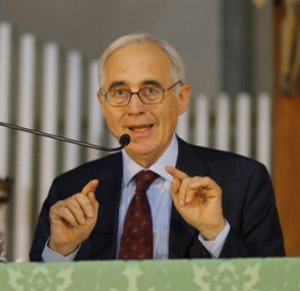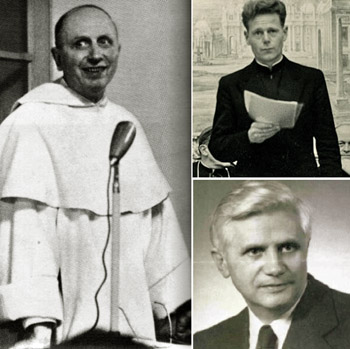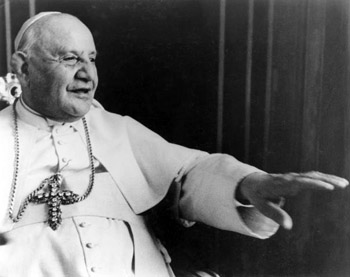Traditionalist Issues
 |
 |
 |
 |
 |
 |
 |
Real Council & Virtual Council – II
Mattei ‘Forgot’ the Revolution
Made by John XXIII
As I showed in a previous article, Roberto de Mattei maneuvered to save the Second Vatican Council in a speech he delivered in Krakow. He tried to convince his audience of the existence of an alleged Virtual Council created by the media that Mattei affirms “was no less real than the one which took place within St. Peter’s Basilica.”
 Mattei used this supposed Virtual or Media Council as a scapegoat to explain away the many problems in the Church since Vatican II: “so many disasters, so many problems, so much suffering, seminaries closed, convents closed, banal liturgy.” He considered this Virtual Council to be the cause of the “calamities” of Vatican II.
Mattei used this supposed Virtual or Media Council as a scapegoat to explain away the many problems in the Church since Vatican II: “so many disasters, so many problems, so much suffering, seminaries closed, convents closed, banal liturgy.” He considered this Virtual Council to be the cause of the “calamities” of Vatican II.
It is true that he also mentioned in his speech some omissions of what he called the Real Council, omissions that we who ask for the annulment of Vatican II have known for years. (1) But what he implies is that all Catholics have to do is remove this evil Council created by the media, fill in some omissions left by Vatican II, and voilà! - the Council is cleansed and can stay!
Mattei’s attempt to present his Virtual Council as responsible for the disastrous consequences of Vatican II is absurd. He is trying to save it, which can only result in the continuation of the Conciliar Revolution that has plagued the Church for the past 50 years.
In order to shatter Mattei’s pretensions, I started to show that the source of the radical changes that occurred in the Church was not any particularly Machiavellian action of the media, but rather the work of the Conciliar Popes themselves. Allow me, then, to continue with the list of Papal actions that caused the calamities of our time. I return to Pope Roncalli’s initiatives.
John XXIII
In the Encyclical Humani generis Pius XII warned against a set of errors that were defended by a current inside the Church: Progressivism. As a result, this current started to be ostracized by many Catholic authorities. But John XXIII rehabilitated the exponents of this current and removed the suspicion hovering over it which remained in official Vatican circles. (2)
It was John XXIII himself who insisted that the most important promoters of Progressivism and the Nouvelle Theologie (New Theology) be included on the theological commission that would write the documents of Vatican II. Yves Congar states: “Fr. de Lubac later told me that it was John XXIII himself who insisted that we both become members of this commission.”(3)
 Philippe Levillain also wrote: “Among the advisers [of the theological commission that prepared the Council] one noted the presence of Frs. Congar, de Lubac, Hans Kung and others. The whole group of theologians implicitly condemned by the Encyclical Humani generis in 1950 had been called to Rome at the behest of John XXIII.” The list of these theologians who became prominent thanks to John XXIII includes Karl Rahner, Yves Congar, Henri de Lubac, Marie-Dominique Chenu, Edward Schillebeeckx, Hans Kung and Joseph Ratzinger. (4)
Philippe Levillain also wrote: “Among the advisers [of the theological commission that prepared the Council] one noted the presence of Frs. Congar, de Lubac, Hans Kung and others. The whole group of theologians implicitly condemned by the Encyclical Humani generis in 1950 had been called to Rome at the behest of John XXIII.” The list of these theologians who became prominent thanks to John XXIII includes Karl Rahner, Yves Congar, Henri de Lubac, Marie-Dominique Chenu, Edward Schillebeeckx, Hans Kung and Joseph Ratzinger. (4)
It was Pope Roncalli who opened the Church to Progressivism, which is Neo-Modernism. Yves Congar gives testimony of this: “Pius X was the Pope who confronted the modernist movement…The movement’s studies continued to follow its irrepressible course, both from outside and within, at times meeting with resistance, problems, controls and restraints. Later, the situation changed profoundly. There was John XXIII (1958-1963), the Council (1962-1965), aggiornamento…”(5)
What has the media to do with any of the above? … Nothing!
John XXIII was also the Pope who “opened the window of the Church” to the world, allowing every bad thing to enter. Henri Fesquet, in his Le Journal du Concile, notes: “Some time ago, when receiving a visitor who asked him what he hoped from the Council, John XXIII pointed to the window and said: ’A current of fresh air in the Church.’” (6)
Who cannot recognize in John XXIII’s opening speech of the Council, which preferred to show “tolerance” and “mercy” for the worst errors and moral evils afflicting the world, an unleashing of the hurricane of permissiveness toward immorality – including homosexuality – that flooded the Catholic Church in the last 50 years? (7) How can any sane, rational person pretend that these enormous doctrinal changes are due to the media?
As part of the celebration of the 50th anniversary of the Council, the president of the John XXIII Foundation, Marco Roncalli, wrote an article entitled “Vatican II in Exhibition” that appeared in the Vatican’s daily newspaper L’Osservatore Romano (Oct.10, 2012, p. 4)
 This article presents an overview of an exhibit that took place in John XXIII’s hometown, Bergamo.
Among the many documents in the exhibit is a note typed by Msgr. Loris Capovilla, John XXIII’s secretary. It was typed on behalf of the Pope giving instructions for the editing of the Bull Humanai salutis that convened the Council.
This article presents an overview of an exhibit that took place in John XXIII’s hometown, Bergamo.
Among the many documents in the exhibit is a note typed by Msgr. Loris Capovilla, John XXIII’s secretary. It was typed on behalf of the Pope giving instructions for the editing of the Bull Humanai salutis that convened the Council.
Handwritten notes from John XXIII himself appear along the side of the typed text proving that John XXIII did not want to follow the general lines of Vatican I because “neither in its substance nor in its form would it correspond to the present day situation.”
In opposition to the militant condemnations and anathemas of the Council of Pius IX, John XXIII insisted that “the Church demonstrates that she wants to be mater et magistra [mother and teacher].”
So, Vatican II was convened explicitly against Vatican I in both its substance [dogma, morals, liturgy, exegesis] and its form [militancy, Thomism, anathemas, condemnations]. It was the Pope himself who commanded the deviation from the straight and narrow course set by Vatican I, which continued the same orientation of the Council of Trent as well as the previous history of the Church. It was the Pope himself who steered the Church into the rocks.
Due to the good graces that Mattei enjoys in Conciliar Rome, he “found in the Vatican Secret Archives a hand-written note by Paul VI that confirms the existence” of The Pact of Metz. But it should be noted in the same L’Osservatore Romano article mentioned above, that it was John XXIII himself, through Cardinal Agostino Bea and the Secretary of State Cardinal Amleto Cicognani, who oriented the Pact of Metz.
This Pact established that Vatican II would not condemn Communism or refer to the Soviet Union, and “the same demand was made for other topics such as peace and Atheism.”
These are some of John XXIII’s actions that gave Vatican II an orientation that it followed to its end.
Mattei’s innuendo that the “real council” of the Fathers should be accepted because all the excesses of the post Vatican II era are a result of the actions of the media is laughable.
Continued


Roberto de Mattei claims the media created the crisis that came from Vatican II
It is true that he also mentioned in his speech some omissions of what he called the Real Council, omissions that we who ask for the annulment of Vatican II have known for years. (1) But what he implies is that all Catholics have to do is remove this evil Council created by the media, fill in some omissions left by Vatican II, and voilà! - the Council is cleansed and can stay!
Mattei’s attempt to present his Virtual Council as responsible for the disastrous consequences of Vatican II is absurd. He is trying to save it, which can only result in the continuation of the Conciliar Revolution that has plagued the Church for the past 50 years.
In order to shatter Mattei’s pretensions, I started to show that the source of the radical changes that occurred in the Church was not any particularly Machiavellian action of the media, but rather the work of the Conciliar Popes themselves. Allow me, then, to continue with the list of Papal actions that caused the calamities of our time. I return to Pope Roncalli’s initiatives.
John XXIII
In the Encyclical Humani generis Pius XII warned against a set of errors that were defended by a current inside the Church: Progressivism. As a result, this current started to be ostracized by many Catholic authorities. But John XXIII rehabilitated the exponents of this current and removed the suspicion hovering over it which remained in official Vatican circles. (2)
It was John XXIII himself who insisted that the most important promoters of Progressivism and the Nouvelle Theologie (New Theology) be included on the theological commission that would write the documents of Vatican II. Yves Congar states: “Fr. de Lubac later told me that it was John XXIII himself who insisted that we both become members of this commission.”(3)

Congar, Kung and Ratzinger - progressivist periti enlisted by John XXIII to write the documents of Vatican II
It was Pope Roncalli who opened the Church to Progressivism, which is Neo-Modernism. Yves Congar gives testimony of this: “Pius X was the Pope who confronted the modernist movement…The movement’s studies continued to follow its irrepressible course, both from outside and within, at times meeting with resistance, problems, controls and restraints. Later, the situation changed profoundly. There was John XXIII (1958-1963), the Council (1962-1965), aggiornamento…”(5)
What has the media to do with any of the above? … Nothing!
John XXIII was also the Pope who “opened the window of the Church” to the world, allowing every bad thing to enter. Henri Fesquet, in his Le Journal du Concile, notes: “Some time ago, when receiving a visitor who asked him what he hoped from the Council, John XXIII pointed to the window and said: ’A current of fresh air in the Church.’” (6)
Who cannot recognize in John XXIII’s opening speech of the Council, which preferred to show “tolerance” and “mercy” for the worst errors and moral evils afflicting the world, an unleashing of the hurricane of permissiveness toward immorality – including homosexuality – that flooded the Catholic Church in the last 50 years? (7) How can any sane, rational person pretend that these enormous doctrinal changes are due to the media?
As part of the celebration of the 50th anniversary of the Council, the president of the John XXIII Foundation, Marco Roncalli, wrote an article entitled “Vatican II in Exhibition” that appeared in the Vatican’s daily newspaper L’Osservatore Romano (Oct.10, 2012, p. 4)

John XXIIII confessed his aim to make Vatican II opposed to Vatican I in substance and form
Handwritten notes from John XXIII himself appear along the side of the typed text proving that John XXIII did not want to follow the general lines of Vatican I because “neither in its substance nor in its form would it correspond to the present day situation.”
In opposition to the militant condemnations and anathemas of the Council of Pius IX, John XXIII insisted that “the Church demonstrates that she wants to be mater et magistra [mother and teacher].”
So, Vatican II was convened explicitly against Vatican I in both its substance [dogma, morals, liturgy, exegesis] and its form [militancy, Thomism, anathemas, condemnations]. It was the Pope himself who commanded the deviation from the straight and narrow course set by Vatican I, which continued the same orientation of the Council of Trent as well as the previous history of the Church. It was the Pope himself who steered the Church into the rocks.
Due to the good graces that Mattei enjoys in Conciliar Rome, he “found in the Vatican Secret Archives a hand-written note by Paul VI that confirms the existence” of The Pact of Metz. But it should be noted in the same L’Osservatore Romano article mentioned above, that it was John XXIII himself, through Cardinal Agostino Bea and the Secretary of State Cardinal Amleto Cicognani, who oriented the Pact of Metz.
This Pact established that Vatican II would not condemn Communism or refer to the Soviet Union, and “the same demand was made for other topics such as peace and Atheism.”
These are some of John XXIII’s actions that gave Vatican II an orientation that it followed to its end.
Mattei’s innuendo that the “real council” of the Fathers should be accepted because all the excesses of the post Vatican II era are a result of the actions of the media is laughable.
Continued
- Plinio Correa de Oliveira, Revolution and Counter Revolution, Omission of Communism in Vatican II, Part III, Chap. II, 4.A. ; Atila Guimaraes, In the Murky Waters of Vatican II (Los Angeles: TIA, 2008), Vol. I, Collection Eli, Eli, Lamma Sabacthani? Communism, p. 171, Hell p. 212.
- Atila Guimaraes,In the Murky Waters of Vatican II , p. 56
- Atila Guimaraes, Animus Delendi I, Vol. IV, Collection Eli, Eli, Lamma Sabacthani? (Los Angeles: TIA, 2000), p. 36
- Ibid., pp. 35,36
- Ibid., p. 35
- Atila Guimaraes, Animus Injuriandi I, Vol. II, Collection Eli, Eli, Lamma Sabacthani? (Los Angeles: TIA, 2010), p. 23
- Atila Guimaraes, Vatican II, Homosexuality & Pedophilia, Special Edition to the Collection Eli, Eli, Lamma Sabacthani? (Los Angeles: TIA, 2004), p. 38

Posted August 15, 2014
______________________
______________________











